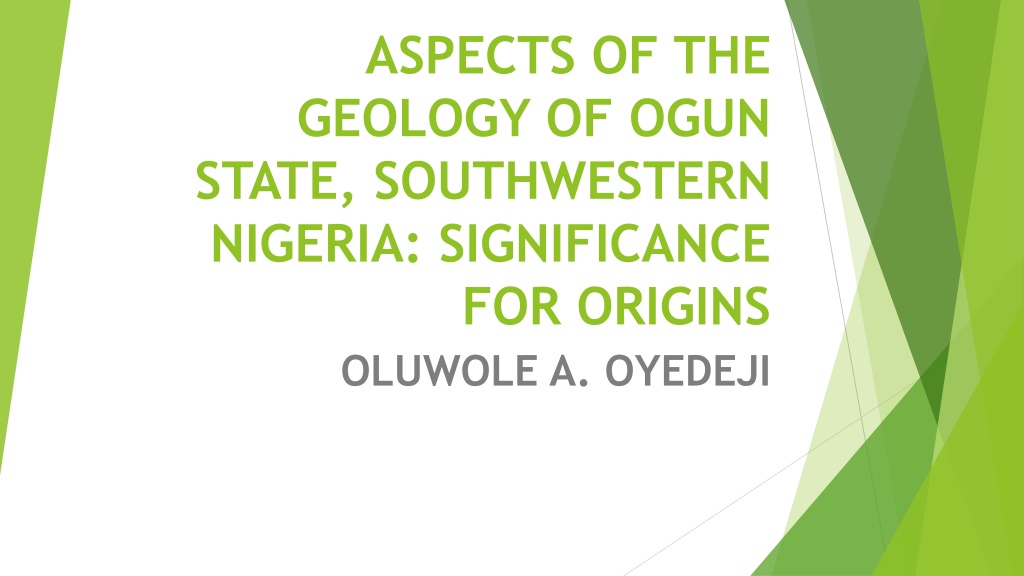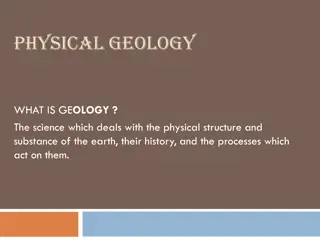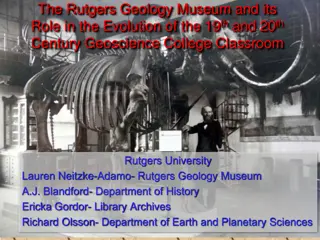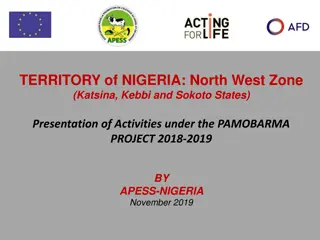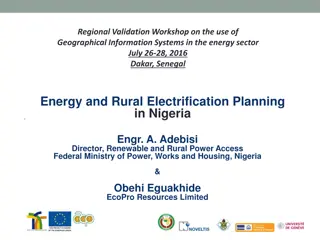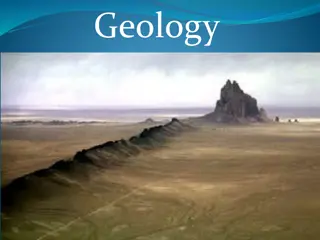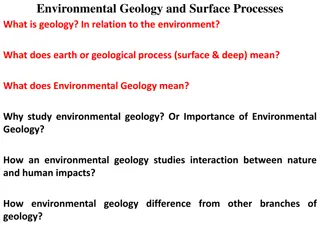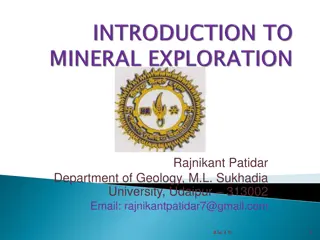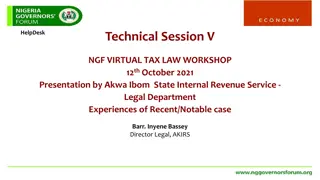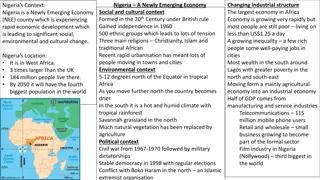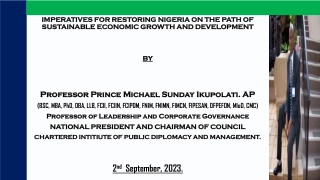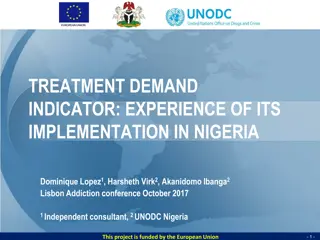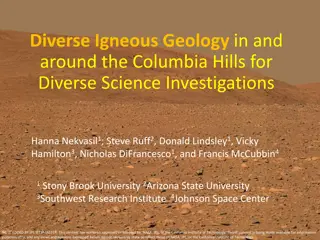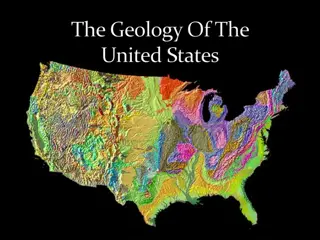Geology of Ogun State, Nigeria: Insights and Implications
The geology of Ogun State in southwestern Nigeria, particularly within the Dahomey or Benin Basin, holds significant value for understanding the region's origins and geological evolution. This includes insights on sedimentary basins, the Wilson Cycle, and the unique characteristics of the Dahomey or Benin Basin. The presentation outlines the geological features, economic aspects, and geotourism potential of the area, shedding light on its importance in the broader context of tectonic history and plate tectonics.
Download Presentation

Please find below an Image/Link to download the presentation.
The content on the website is provided AS IS for your information and personal use only. It may not be sold, licensed, or shared on other websites without obtaining consent from the author. Download presentation by click this link. If you encounter any issues during the download, it is possible that the publisher has removed the file from their server.
E N D
Presentation Transcript
ASPECTS OF THE GEOLOGY OF OGUN STATE, SOUTHWESTERN NIGERIA: SIGNIFICANCE FOR ORIGINS OLUWOLE A. OYEDEJI
PRESENTATION OUTLINE Sedimentary Basins Location Dahomey OR Benin Basin Origin and Morphology Geology of Ogun state Economic Geology Geotourism sites Origins Significance for a young age Conclusions
LOCATION OF OGUN STATE, SW NIGERIA Ogun state falls within the Dahomey or Benin Basin THE SEDIMENTARY BASINS IN NIGERIA One of the seven Basins in Nigeria Others are Sokoto or Iullemeden, Benue trough, Chad Basin, Bida or Nupe Basin, Anambra Basin, Niger Delta and Dahomey Except the Anambra and the Bida Basins, all traverse international boundaries
SEDIMENTARY BASINS Regions of earth where long-term subsidence have created accommodation space for filling by sediments Occur in diverse geologic settings usually associated with plate tectonic activity-Divergent, Convergent, transform, hybrid Crustal extension- Rifting e.g. Benue trough, may be intracratonic e.g, Chad, Passive Margin e.g. Dahomey or Benin Others-Subduction, strike-slip faulting The rock sequences that fill up Basins constitute the stratigraphic record useful for the reconstruction of tectonic history
THE WILSON CYCLE The Wilson cycle is named after the Canadian geophysicist J. Tuzo Wilson (1908-1993 The cyclical opening and closing of ocean basins caused by movement of the Earth s plates. The Wilson cycle begins with a rising plume of magma and the thinning of the overlying crust. As the crust continues to thin due to extensional tectonic forces, an ocean basin forms and sediments accumulate along its margins. Subsequently subduction is initiated on one of the ocean basin s margins and the ocean basin closes up. When the crust begins to thin again, another cycle begins. Source: https://www.geologypage.com/2013/01/wilson-cycle.html
DAHOMEY OR BENIN BASIN One of the many marginal Basins along the coasts of Africa and Brazil A sinistral wrench fault feature at the southernmost end of the Benue Trough Occurs as a coast-parallel depression stretching the western limit of the Niger Delta westwards through Benin Republic and Togo Terminates east of Accra in Ghana Has a latitudinal stretch of about 500km Attains its widest onshore expanse of about 170km around the Nigeria-Benin frontier
ORIGIN OF THE DAHOMEY BASIN- WORLDVIEW Source: gstatic.com/images
strike-slip fault, also called transcurrent fault, wrench fault, or lateral fault, Fracture in the rocks of Earth s crust in which the rock masses slip past one another Caused by horizontal compression, Energy is released by rock displacement in a horizontal direction Source: Universidad Fernando Pessoa
GEOLOGICAL FRAMEWORK OF THE BASIN (After Billman, 1992) showing the wrench faulting Outcrop area is concave seaward, roughly reflecting the succession of ancient coastlines Four broad geomorphic zones Northern uplands, Ewekoro Depression, southern uplands and the Coastal Margin
GEOLOGY OF OGUN STATE Underlain in the south by sedimentary rock (Jones and Hockey, 1964) lying unconformably on the Basement The Cretaceous --Abeokuta Group the Cenozoic units (Ewekoro, Ilaro and the Coastal plain sands Underlain to the north by rocks which belong to the Basement complex of Nigeria Porphyritic Granite Mica Schist
The sedimentary Formations in Ogun state Ewekoro Formation Predominantly limestone, marl, and overlying shales. It is fossiliferous in places Ilaro Formation Predominantly sand but with considerable fractions of clay and shale. It is also fossiliferous and phosphatic Coastal plain sands soft, very poorly sorted Sands, pebbly in places,
SIMPLIFIED GEOLOGICAL MAP OF SOUTHWESTERN NIGERIA
BRIEF DESCRIPTIONS OF THE FORMATIONS Abeokuta Formation-- Predominantly coarse- grained sands, consolidated in places, with intercalations of hard ferruginous pans, silt, mudstone and clays Babcock University is underlain by the Abeokuta Formation Hosts the bitumen/tarsand deposit (Yemoji) Abeokuta Formation is the oldest Formation in the Basin
HISTORY/STRATIGRAPHY OF THE SEDIMENTARY ROCKS IN THE DAHOMEY BASIN(Adapted After Kogbe, 1989) ERA PERIOD AGE MILLIONS OF YEARS EOCENE (57.8-36.6) FORMATION ILARO FORMATION TERTIARY OSHOSUN FORMATION CENOZOIC PALAEOCENE AKINBO FORMATION (66.4-57.8) EWEKORO FORMATION MESOZOIC CRETACEOUS MAASTRICHTIAN ABEOKUTA FORMATION (72.0-66.0) > 545 PALAEOZOIC PRECAMBRIAN BASEMENT COMPLEX THE AGES ASSIGNED WERE BASED ON THE MACRO FAUNAL CONTENT AND RADIOACTIVE METHODS ALL THE AUTHORS DO NOT AGREE ON THE DATING.
Clastic Sediments in Ogun state Formed of fragments of weathered rocks or shells - Sand, clay, boulders and shell fragments are examples. Clastic sedimentary rocks are named according to the sizes of the particles. Abeokuta Formation, Ilaro Formation which comprise sandstone and shale
NON-CLASTIC OR CHEMICAL SEDIMENTS IN OGUN STATE EWEKORO FORMATION(LIMESTONE)
SECTION OBSERVED AT THE LAFARGE QUARRY, EWEKORO (Oyedeji and Ezeribe, 2007) Limestone Shale
PALEONTOLOGY (After Jones and Hockey, 1964) FORMATION ABEOKUTA EWEKORO TYPE OF ASSOCIATED FOSSILS Micro fossils (Foraminifera, Ostracods) Fish Molluscs (Gastropods, Bivalves) Microfossils (Ostracods) Ilaro Coastal plain sands
ECONOMIC GEOLOGY Limestone, Construction materials Sand, brick clay, crushed stones and aggregates, Phosphates,Tar sands/Bitumen BITUMEN BRICK CLAY SAND FOR CONSTRUCTION
GEOTOURISM SITES Olumo rock Tar sand oozing site, Yemoji Cement factories-Ewekoro, Sagamu, Ibeshe
STANDARD MODEL FOR THE ORIGIN OF THE SEDIMENTARY ROCKS Clastic Formation involves erosion, transportation and deposition followed by lithification and diagenesis Shale: Formed from clay deposited in a low energy environment, usually considered to be deposited slowly from quiet water in a marine or lake environment Non-clastic e.g. Limestone- CaCO3 is precipitated by organisms usually to form a shell or other skeletal structure. Accumulation of these skeletal remains results in a limestone This would seem to take time Tarsands/bitumen- Semiliquid- semisolid to solid petroleum in rock.
HOW WERE THE CLASTIC SEDIMENTS FORMED?
HOW WERE THE NON-CLASTICS CHEMICAL AND ORGANIC ROCKS FORMED? Non-clastic rocks are created when water evaporates or from the remains of plants and animals. ORGANIC-- formed from the dead remains of plants. Millions of years ago, plants fell into swamps. They were covered with layers of sediment and did not rot. Over long period of years, as the remains were buried deeper under more and more layers of sediment, they were changed by pressure
ORIGIN OF THE ROCKS AND THE BASIN in light of BIBLICAL HISTORY The sediments deposited have widespread occurrence They are predominantly clastic Deposition may not require long time as assigned Fossil assemblage in the sands are different from the overlying limestone and shale These are more consistent with catastrophic transport, then burial during or after the massive global flood of Noah s day.
ILLUSTRATION OF HIGH ENERGY TRANSPORTATION AND QUICK SEDIMENTATION (Oyedeji 2019)
ILLUSTRATION OF UNDERWATER DEPOSITION (Flood Model) The flood covered all the high mountains Gen 7:19,20 and all living things were blotted out. Gen 7:23 The flood was accompanied by earthquakes, which triggered tsunamis, and erosion and sedimentation on a large scale. The opening of the fountains of waters (Gen. 7:12) may refer to underwater volcanism or materials from deep inside spewing out into the ocean basins.
SIGNIFICANCE OF THE ROCKTYPES FOR A YOUNG AGE The beds are almost horizontal Little evidence of faulting, No Folding
QUESTIONS THAT STILL NEED TO BE ANSWERED Do basement rock represent pre-flood history? Are the sedimentary events related to the main part of the flood? Or were they post flood?
WORK IN PROGRESS (Nalin, Clausen, Oyedeji and others) Provenance and geochronology of Cretaceous to Holocene deposits of the Dahomey Basin, Nigeria, by means of U-Th dating of detrital zircons Samples collected: Sediments and Bedrock Goals: Peaks of crust formation and magmatic history of the African continent - Stability of sediment transport after Pangea break-up (post flood) Results so far The post break-up provenance patterns will be useful in organizing a Biblical approach to earth history for the African continent.
CONCLUSIONS-1 The sedimentary aspect of the geology of Ogun state has been presented The scientific worldview for the origins of the rocks have also been presented. Biblical view on the origin of the rocks has also been presented The events as described by the standard model are real, though we may not agree with the time and ages assigned. The ages have contentious issues Organic origin for the tarsands and bitumen can be assumed. (i.e., the conversion of sedimentary organic matter as a result of heating and transformation to form oil and gas).
CONCLUSIONS -2 In the beginning, the Bible says God created the heavens and the earth Genesis 1:1, Nothing was made without Him. John 1:3 Issues of conflict over origins need to be aggressively researched so that we can have models to support Biblical creation
